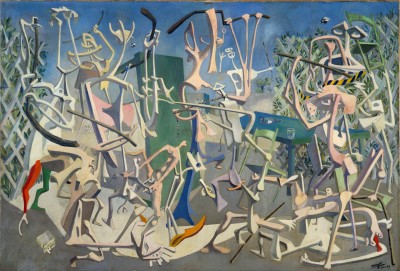Think you know Surrealism? Meet Egypt’s radical dreamers
Think you know Surrealism? Meet Egypt’s radical dreamers
By Anna Wallace-Thompson
Published 6 December 2017
Salvador Dalí may have made Surrealism famous, but an overlooked group of artists, writers and activists in 1940s Cairo made the movement their own. Here we look at their pioneering work, currently on show at Tate Liverpool.
-
-
In 1938, Cairo was a like a pressure cooker about to blow. The yoke of colonialism was chafing and for many the idea of self-government was becoming increasingly appealing. Poverty was rife and people were even discussing the benefits of Fascism. Then with the outbreak of the Second World War the city, as a British Protectorate, had welcomed – and was struggling to accommodate – 200,000 Commonwealth soldiers who arrived during 1939-41. The seeds of the Egyptian Revolution of 1952 were being sown.
For members of the liberal intelligentsia, these were troubling times. Art was expected to be nationalistic, with idealised visions of Egypt, and anything outside these bounds, such as more abstract works, was considered morally corrupt. As 1938 drew to a close, brothers Anwar Kamel (a writer and activist) and Fouad Kamel (an artist), alongside author George Henein and artist Kamel El-Telmisany, could no longer hold back, and so published their revolutionary manifesto Vive L’Art Degenere (Long Live Degenerate Art), signed by 37 artists, writers and lawyers. It was this cry in the dark against the smothering of self-expression that catalysed the creation of the surrealist Art and Liberty Group, a diverse conglomerate of writers, artists, filmmakers, activists and intellectuals.
The Art and Liberty Group sought to create a new cultural vernacular to address local issues, but using an international artistic language. Regarding themselves as Surrealists in Egypt rather than “Egyptian Surrealists” (ergo, copycats of the school of Dalí and Magritte), they exchanged ideas with the global network of Surrealist movements of the time. From Paris to Bulgaria and beyond, few today realise just how far the Surrealist network spread in the 1920s and ’30s, and the intellectual exchange between the Art and Liberty Group and the world was extensive.

-
-
-

As such, members of the group tackled the issues of their time such as police brutality, dramatically captured by Greek-Egyptian artist Mayo in his 1937 painting Coups de Bâtons (Sticks), and prostitution. Kamel El-Telmisany’s 1940 work Untitled (Wounds) hauntingly depicts women being crucified – by life, by circumstance, by war. Pharaonic imagery was used as government propaganda, so where such elements are used by Art and Liberty artists these appear broken and twisted. An untitled 1939 painting by Ramses Younane depicts the body of a goddess bent at awkward angles, while Ida Kar’s collage-like photographs subvert images of Egyptian temples and icons, with flesh-flecked ribs instead of temple columns and majestic pyramids cupped in the palm of a hand. Elsewhere, Amy Nimr’s vividly hazy paintings depict skeletons submerged in the ocean, reflecting the artist’s grief at the loss of her 10-year-old son in a bomb blast.
By the early 1950s, the group had begun to disband; after the coup in 1952 led by General Nasser some fled into exile for fear of imprisonment. Since then, the Art and Liberty Group has been dismissed as a failed attempt to impose Occidental values on Egyptian art.
Now that conclusion is being reassessed following research by Sam Bardaouil and Till Fellrath, curators of the Tate Liverpool show Surrealism in Egypt, who stumbled across the group when preparing another exhibition. What followed was five years of painstaking study, over 200 interviews and a complete recalibration of our understanding, not only of the history of art in Egypt, but of the history of Surrealism and its influence across the world.
The Art and Liberty Group period is arguably one of the Egyptian art scene’s most important chapters. That so little was previously known about it is somewhat tragic. Now, bringing together 115 artworks from 33 private and public collections across 10 countries, Surrealism in Egypt offers an insight into the country’s post-war political and social climate, and bears testament to the great intellectual achievements of one of the most creatively rich periods in modern Egyptian history.
-
-

Fouad Kamel, Nude, 1950.

Amy Nimr, Untitled (Underwater skeleton), 1940.

Inji Efflatoun, Untitled, 1942.

Mayo, Coups de Bâtons, 1937.
-
Anna Wallace-Thompson is a writer specialising in Middle Eastern art and culture
Surrealism in Egypt: Art et Liberté 1938–1948 is at Tate Liverpool until 18 March 2018.









